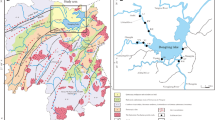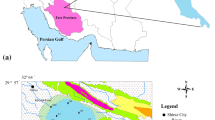Abstract
Thirty-five alluvial sediments of the River Danube and 12 groundwater samples were taken within the Pančevo Oil Refinery (Serbia). The results for groundwater samples exceed European primary drinking water standards for Fe (obtained results, >200 μg/l) and Mn (obtained results, >50 μg/l), while the levels of the trace metals are below the thresholds for drinking water quality. Sediments were treated by sequential extraction procedure with five different solutions, each having a higher extraction capacity than the previous one. We also wanted to determine the possible relationships among trace metals and between sediment properties and elemental concentrations. These solutions partitioned metals into CH3COONH4 extractable (F1); HCl carbonate extractable and NH2OH·HCl easily reducible (F2); (NH4)2C2O4/H2C2O4 moderately reducible (F3); H2O2–HNO3 organic/sulfide extractable fractions (F4); and HCl acid-soluble residue (F5). The sum of trace metals Ni, Pb, Cu, and Zn associated with the first two fractions (exchangeable, carbonate, and easily reducible) is significant and extremely important because it represents the proportion of heavy metals that can be easily remobilized by changes in environmental conditions such as pH, redox potential, salinity, etc. Sediments located nearer the groundwater flow are exposed to stronger groundwater fluctuation and had a higher quantity of amorphous and less stable substrates of trace metals. Principal component analysis was used to understand and visualize the associations between the trace metals and certain geological forms within analyzed sediments. The observed association between Cr with total sulfur and Mn from the acid-soluble residue could indicate that Cr is in the form of reduced, less toxic Cr(III), which is from the ecochemical point of view very important.
Similar content being viewed by others
References
Adamo, P., Arienzo, M., Imperato, M., Naimo, D., Nardi, G., & Stanzione, D. (2005). Distribution and partition of heavy metals in surface and sub-surface sediments of Naples City port. Chemosphere, 61, 800–809.
Alomary, A. A., & Belhadj, S. (2007). Determination of heavy metals (Cd, Cr, Cu, Fe, Ni, Pb, Zn) by ICP-OES and their speciation in Algerian Mediterranean Sea Sediments after a five-stage sequential extraction procedure. Environmental Monitoring and Assessment, 135, 265–280.
Bacon, J. R., & Davidson, C. M. (2008). Is there a future for sequential chemical extraction? The Analyst, 133, 25–46.
Balkis, N., & Çağatay, M. N. (2001). Factors controlling metal distribution in the surface sediments of the Erdek Bay, Sea of Marmara, Turkey. Environment International, 27, 1–13.
Borovec, Z. (1996). Evaluation of the concentrations of trace elements in stream sediments by factor and cluster analysis and the sequential extraction procedure. Science of the Total Environment, 177, 237–250.
Davidson, C. M., Hursthouse, A. S., Tognarelli, D. M., Ure, A. M., & Urguhart, G. J. (2004). Should acid ammonium oxalate replace hydroxylammonium chloride in step 2 of the revised BCR sequential extraction protocol for soil and sediments? Analytica Chimica Acta, 508, 193–199.
Davidson, C. M., Urquhart, G. J., Ajmone-Marsan, F., Biasioli, M., da Costa Duarte, A., Díaz-Barrientos, E., et al. (2006). Fractionation of potentially toxic elements in urban soils from five European cities by means of a harmonized sequential extraction procedure. Analytica Chimica Acta, 565, 63–72.
Doelsch, E., Moussard, G., & Macary, H. S. (2008). Fractionation of topical soilborne heavy metals—Comparison of two sequential extraction procedures. Geoderma, 143, 168–179.
Facchinelli, A., Sacchi, E., & Mallen, L. (2001). Multivariate statistical and GIS-based approach to identify heavy metal sources in soils. Environmental Pollution, 114, 313–324.
Filgueiras, A. V., Lavilla, I., & Bendicho, C. (2004). Evaluation of distribution mobility and binding behaviour of heavy metals in surficial sediments of Louro River (Galicia, Spain) using chemometric analysis: A case study. Science of Total Environment, 330, 115–129.
Fitamo, D., Itana, F., & Olssom, M. (2007). Total content and sequential extraction of heavy metals in soils irrigated with wastewater, Akaki, Ethiopia. Environmental Management, 39, 178–193.
Gallego, J. L. R., Ordóñez, A., & Loredo, J. (2002). Investigation of trace element sources from an industrialized area (Avilés, northern Spain) using multivariate statistical methods. Environment International, 27, 589–596.
Ghrefat, H., & Yusuf, N. (2006). Assessing Mn, Fe, Cu, Zn, and Cd pollution in bottom sediments of Wadi Al-Arab Dam, Jordan. Chemosphere, 65, 2114–2121.
Gleyzes, C., Tellier, S., & Astruc, M. (2002). Fractionation studies of trace elements in contaminated soils and sediments: A review of sequential extraction procedures. Trends in Analytical Chemistry, 21, 451–467.
Guvenç, N., Alagha, O., & Tuncel, G. (2003). Investigation of soil multi-element composition in Antalya, Turkey. Environment International, 29, 631–640.
Jain, C. K. (2004). Metal fractionation study on bed sediments of River Yamuna, India. Water Research, 38, 569–578.
Jain, C. K., Gupta, H., & Chakrapani, G. J. (2008). Enrichment and fractionation of heavy metals in bed sediments of River Narmada, India. Environmental Monitoring Assessment, 141, 35–47.
Jouanneau, J. M., Latouche, C., & Pautrizel, F. (1983). Critical analysis of sequential extractions through the study of several attack constituent residues, (Analyse Cr!tique des Extractions sequentielles a Travers l’Etude de ouelques Constituants des Residus d’Attaque). Environmental Technological Letters, 4, 509–514.
Kostić, N. (2001) Distribution and chemical speciation of some heavy metals in soils of Vojvodina and Central Serbia. In Proceedings of the 10th Congress of Yugoslav Soil Science Society, CD copy by Soil Sciences Institute, Belgrade.
Maiz, I., Arambarri, I., Garcia, R., & Millán, E. (2000). Evaluation of heavy metal availability in polluted soils by two sequential extraction procedures using factor analysis. Environmental Pollution, 110, 3–9.
Martello, L., Fuchsman, P., Sorensen, M., Magar, V., & Wenning, R. J. (2007). Chromium geochemistry and bioaccumulation in sediments from the lower Hackensack River, New Jersey. Archives of Environmental Contamination and Toxicology, 53, 337–350.
McAlister, J. J., Smith, B. J., & Curran, J. A. (2003). The use of sequential extraction to examine iron and trace metal mobilisation and the case-hardening of building sandstone: A preliminary investigation. Microchemical Journal, 74, 5–18.
Morillo, J., Usero, J., & Gracia, I. (2005). Study of fractionation and potential mobility of metal fro the Guadalquivir Estuary: Changes in mobility with time and influence of the Aznalcollar Mining spill. Environmental Management, 36, 162–173.
Navas, A., & Lindhorfer, H. (2003). Geochemical speciation of heavy metals in semiarid soils of the central Ebro Valley (Spain). Environment International, 29, 61–68.
Nenadić, D., Simić, V., & Knežević, S. (2001). Stratigraphical and lithological characteristics of Preloess sediments in Eastern Srem (Serbia). Annales géologiques de la péninsule Balkanique, 64, 53–62.
Pickering, W. F. (1986). Metal ion speciation; soils and sediments (a review). Ore Geological Review, 1, 83–146.
Polić, P., & Pfendt, P. (1994). Alluvial aquifer conatmination: Exchangeable heavy metals and factors affecting their spatial distribution. Water, Air and Soil Pollution, 74, 155–167.
Polić, P., & Pfendt, P. (1996). Alluvial aquifer contamination: Carbonates and easily reducible oxyhydroxides as heavy metal substrates. Journal of Serbian Chemical Society, 61, 1001–1013.
Reimann, C., & Filzmoser, P. (2000). Normal and lognormal data distribution in geochemistry: Death or myth. Consequences for the statistical treatment of geochemical and environmental data. Environmental Geology, 39, 1001–1014.
Relić, D., Đorđević, D., Popović, A., & Blagojević, T. (2005). Speciations of trace metals in the Danube alluvial sediments within an oil refinery. Environment International, 31, 661–669.
Rodríguez, L., Ruiz, E., Alonso-Azcárate, J., & Rincón, J. (2009). Heavy metal distribution and chemical speciation in tailings and soils around a Pb–Zn mine in Spain. Journal of Environmental Management, 90, 1106–1116.
Ruiz, F., Gonzalesregaldo, M. L., Borrego, J., Morales, J. A., Pendon, J. G., & Munoz, J. M. (1998). Stratigraphic sequence, elemental concentrations and heavy metal pollution in Holocene sediments from the Tinto-Odiel Esturay, Southwestern Spain. Environmental Geology, 34, 270–278.
Sakan, S., Gržetić, I., & Đorđević, D. (2007). Distribution and fractionation of heavy metals in the Tisa (Tisza) river sediments. Environmental Science and Pollution Research, 14, 229–236.
Škrbić, B., & Čupić, S. (2004). Trace metal distribution in surface soils of Novi Sad and bank sediment of the Danube River. Journal of Environmental Science and Health, Part A—Toxic/Hazardous Substances & Environmental Engineering, 39, 1547–1558.
Tessier, A., Campbell, P. G. C., & Bisson, M. (1979). Sequential extraction procedure for the speciation of particulate trace metals. Analytical Chemistry, 51, 844–851.
Todorović, Z., Polić, P., Đorđević, D., & Antonijević, S. (2001). Lead distribution and its association with sediment constituents of the “Barje” lake (Leskovac, Yugoslavia). Journal of the Serbian Chemical Society, 66, 697–708.
von Brömssen, M., Larsson, S. H., Bhattacharya, P., Hasan, M. A., Ahmed, K. M., Jakariya, M., et al. (2008). Geochemical characterization of shallow aquifer sediments of Matlab Upazila, Southeastern Bangladesh—Implications for targeting low-As aquifers. Journal of Contaminant Hydrology, 99, 137–149.
Walsh, A. R., & O’Halloran, J. (1996). Chromium speciation in tannery effluent—II. Speciation in the effluent and in a receiving estuary. Water Research, 30, 2401–2412.
Yu, K. C., Tsai, L. J., Chen, S. H., & Ho, S. T. (2001). Correlation analyses on binding behavior of heavy metals with sediment matrices. Water Research, 35, 2417–2428.
Author information
Authors and Affiliations
Corresponding author
Electronic supplementary material
Below is the link to the electronic supplementary material.
Rights and permissions
About this article
Cite this article
Relić, D., Đorđević, D., Popović, A. et al. Fractionation and potential mobility of trace metals in Danube alluvial aquifer within an industrialized zone . Environ Monit Assess 171, 229–248 (2010). https://doi.org/10.1007/s10661-009-1274-1
Received:
Accepted:
Published:
Issue Date:
DOI: https://doi.org/10.1007/s10661-009-1274-1




